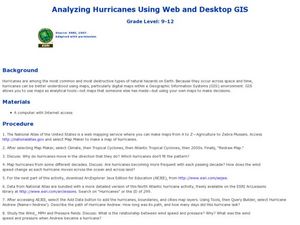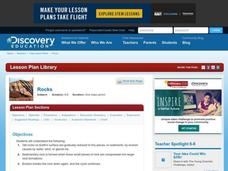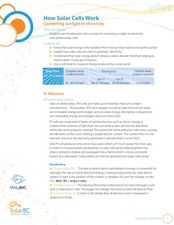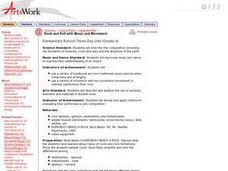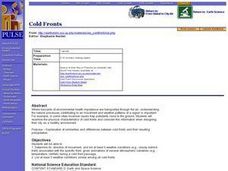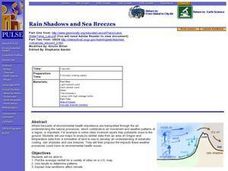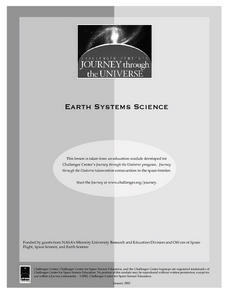Curated OER
Analyzing Hurricanes Using Web and Desktop GIS
Students analyze hurricanes. In hurricanes lesson, students use the Internet and GIS to analyze hurricanes. Students view the National Atlas of Maps to discuss the direction hurricanes move. Students study the wind and pressure fields to...
Curated OER
Rocks
Learners examine how sedimentary rocks are formed. In this rock lesson students research different rock formations and different types of rock.
Curated OER
How Solar Cells Work: Converting Sunlight to Electricity
Students examine how to convert sunlight to electricity. In this renewable energy sources lesson students explain how solar cells are used and use a voltmeter to measure the energy produced by a solar panel.
Curated OER
Olympic Solar Energy
Students use cardboard and aluminum foil to construct a solar oven that concentrates enough sunlight to cook a hotdog. They review the history and use of solar energy in relation to the Olympics.
Curated OER
Rock and Roll with Music and Movement
Fourth graders improvise music and dance to express their analysis of types of rocks. They discuss the three classes of rocks, list describing words, and create a short musical piece and dance to symbolize the rock they are dancing.
Curated OER
What's Happening to the Ozone?
High schoolers identify causes of ozone depletion, generalize how that information affects everyday life, and discuss ways individuals can help slow down depletion of ozone.
Curated OER
Volcanoes And Atmospheres
Students identify the volcano as the primary source of atmospheric gases, to explain the formation of ozone, and to recognize the dangers of volcanic gases through the use of technology in the classroom.
Curated OER
Cold Fronts
Pupils determine its' direction of movement, and list at least five weather conditions associated with the specific front, given animations of several atmospheric variables during a cold front passage. They list at least three weather...
Curated OER
Rain Shadows and Sea Breezes
Students plot the average rainfall for a variety of cities in the United States. Using the map, they work together to determine patterns on which toxicants are transported through the air. They determine the impacts of various weather...
Curated OER
Exploring Rocks
Students recognize differences in the size, shape, texture, and color of different rocks. In this rocks lesson plan, students also learn and repeat back how a volcano erupts and make one out of a toilet paper tube.
Curated OER
The Environments of Big Sur -- Which Do We Protect?
Students investigate the geological, climatic, and biological features of Big Sur. They watch a video, conduct Internet research, and create a script and images in the form of an outline in a simulation of an environmental group.
Curated OER
Weather: It Works, or Not?
Students discover the techniques meteorologists use to examine the atmosphere. In groups, they build their own weather station and observe the various weather conditions. They identify the types of weather patterns that allow the...
Curated OER
Planetary Weather
Middle schoolers study the weather on other planets in our solar system. In this planetary weather instructional activity students create a display of the different weather conditions on the other planets.
Curated OER
Personal Written Response Activity
Students complete a final written project. In this personal response lesson, students respond in a creative way to one of the issues presented in the unit. Students may choose to create a series of postcards from a natural...
Curated OER
My Friend, The Volcano
Students describe the positive impacts of volcanic activity on marine ecosystems. In this volcano lesson plan students explore the process that causes volcanic activity along the Mariana and Kermadec Island Arcs.
Curated OER
Modeling Oil and Gas Reservoirs
Students investigate energy by researching how oil reservoirs work. In this fossil fuels instructional activity, students conduct an experiment using a half full bottle of water, corn oil and oxygen, recording their data as the elements...
Curated OER
It looks Like Champagne
Students interpret phase diagrams and explain the meaning of vocabulary words. In this ocean explorer lesson plan students describe two uses of super-critical carbon dioxide.
Curated OER
Carving Mountains
Students explore geography by participating in an illustration activity. In this land-form lesson, students define vocabulary terms associated with glaciers and forests. Students utilize pens, cardboard and pottery clay to draw and...
Curated OER
What is in Soil?
Fourth graders identify and examine the components that make up soil. Individually, they use a magnifying glass to identify the organic and inorganic material in their soil sample. To end the lesson, they record the differences in the...
Curated OER
Earthquake Waves
In this waves worksheet, students read about the different types of waves associated with earthquakes. Then students complete 1 fill in the blank and 2 short answer questions.
Curated OER
Sediment Deposition Lab
High schoolers set up a stream table, observe erosion, and record data on where various sizes of sediments settle. They draw conclusions as to what kind of sedimentary rock form in what locations.
Curated OER
The World's Spheres Vocabulary
In this world's spheres activity, students are given nine spheres and they match the given definitions of the sphere with the term.
Curated OER
Volcanoes
Young scholars study volcanoes. In this volcanoes lesson, students read several volcano paragraphs and study the pictures or diagrams. Young scholars then make an erupting volcano, complete website research about volcanoes, and answer...
Curated OER
Processes of the Rock Cycle
Young scholars explore, predict, and create each major rock form (sedimentary, metamorphic, and igneous) with colored modeling clay, discover cycle of rock formation, and examine important relationships of heat and pressure in rock...


